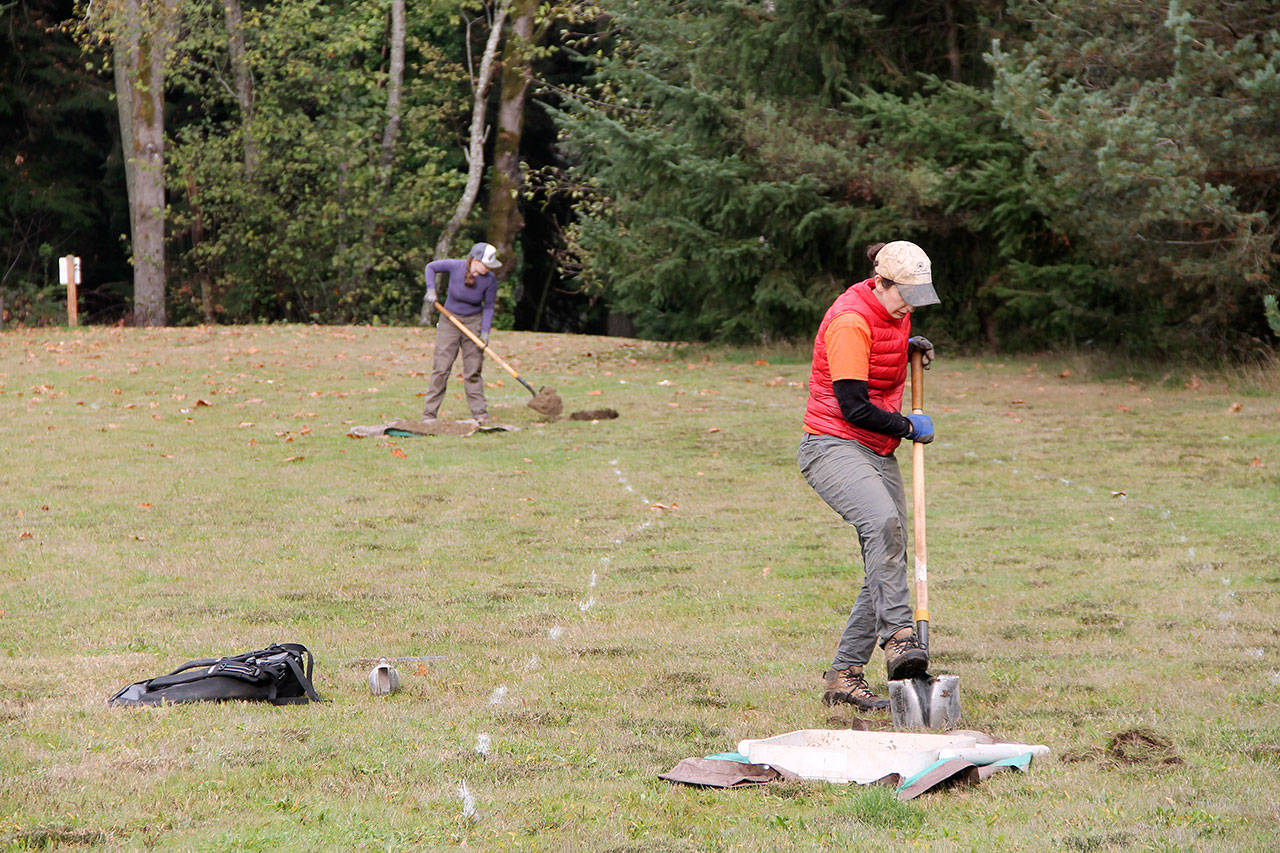Archaeologist Amanda Taylor of the Willamette Cultural Resources Associates was digging near the skate bowl at the Burton Adventure Recreation Center (BARC) last week, searching for any clues of the past hidden there.
Before the crowdfunded skate park project to construct Washington’s first outdoor concrete pump track can commence, the state requires that work sites thought to have been used by European settlers or native people for any number of activities undergo a cultural resources survey.
That work, said Taylor, honors the contributions and legacies of those who came first while informing the decision-making process behind historic preservation for generations to come.
Many islanders remember the former Burton Elementary School, originally built in 1953, that once stood on the hill where the skate park is located. But some may not know that the surrounding area, including neighboring Judd Creek and Quartermaster Harbor, held importance to many throughout the years — including before recorded history.
Half a century before the first ramp was constructed in the covered building at the formerly named Burton Street Course, the Kaguni Family farmed loganberries along the south side of Judd Creek, until they were exiled and imprisoned as a result of Executive Order 9066, issued by President Franklin D. Roosevelt in 1942.
Looking further back, photographs provided by the Vashon Heritage Museum appear to show much of the slope of the park being used for agriculture. Island historian Bruce Haulman noted that Civil War veteran Artemus Judd, whom the creek is named after, established a homestead in the vicinity. And long before him, native village sites were built all around Quartermaster Harbor and possibly at the creek.
Taylor said she was not aware of any explicit use of the site where the pump track will be built. But evidence of former activities can vary widely.
“There are all kinds of objects that are telltales of an archaeological site,” said Taylor.
Those include anything from stone tools to old nails or remnants of a hearth, rocks still visibly scarred by campfire or charcoal left buried in the earth. Taylor said that bottles with old makers marks on them may signify an archaeological site, as would discovering early whiteware, limestone ceramics which she noted are distinctive from the old heirloom china most can imagine packed away in the attics of their relatives or families homes.
Before the archaeological team begins their fieldwork, they research everything they can learn about the land they will be investigating, said Taylor. The probe she was working on — a hole in the ground about 50 centimeters in diameter — was meant to help her better understand the site’s human and ecological history.
“We’re really taking a sample,” Taylor said. “We’re trying to make sure that we get a good look in enough spots that we can feel comfortable about what we’ve determined about the landscape.”
Taylor said that through her work, she has seen amazing evidence of the way people once lived. Having surveyed other locations on the island before, she said Vashon’s array of shell midden sites — areas consisting of layers of disposed of shellfish where harvests were clearly processed — interest her greatly.
But it was not her intention to make an impressive discovery at the park during the cultural resources survey.
“We are, of course, interested in things of the past,” she said, “but our job isn’t so much to find artifacts or sites. Often time it is to make sure that there aren’t any.”
Brandon Reynon, of the Puyallup Tribe’s Historic Preservation Office, told The Beachcomber that a flat, level surface such as where the pump track will be built may have been a place where native people competed with one another, playing games and socializing.
“It’s very well that this place could have been used for recreation, so seeing today that it’s being used that way brings it full circle,” he said.
Reynon added his appreciation for Judith Neary of the island nonprofit RJs Kids — the organization which obtained the $150,000 King County Youth Athletic Facilities grant last May to build the pump track — as it was her decision to actively involve the tribe before proceeding.
“I think it’s really great that the person driving the project saw it a priority to reach out,” he said.
Neary said she was grateful to the representatives of the Puyallup tribe who walked the site with organizers and discussed the project with them as well as the Native American heritage of Quartermaster Harbor and Judd Creek. There are plans, Neary said, to create and install a story plaque at the park dedicated to that history of the area.
She added that the in-ground skate bowl, constructed in 2014, was inexplicably not subject to a cultural resource review at the time. But as organizers have begun the task of obtaining permits for the work to begin Phase 2 of the BARC master plan, which calls for additional skating infrastructure, an exercise station and native landscaping, Neary said she is pleased the work will unfold respectfully.
Designed by West Seattle-based Grindline Skateparks, the pump track will serve skateboarders, BMX bike riders and rollerbladers who will use their own momentum to cruise over the track’s turns and mounds without having to push or pedal. Once the bid process for choosing a company to lead the work is complete, organizers will develop a construction calendar and work parties will be invited to help bring Phase 2 to fruition.
Several island organizations have expressed interest in supporting the project, and recent events at BARC such as a free, all-ages concert to bring awareness to its revitalization make Neary optimistic about what the future holds.
“I’m very appreciative of the folks who have stepped up and helped me continue realizing the vision for this project,” she said.



